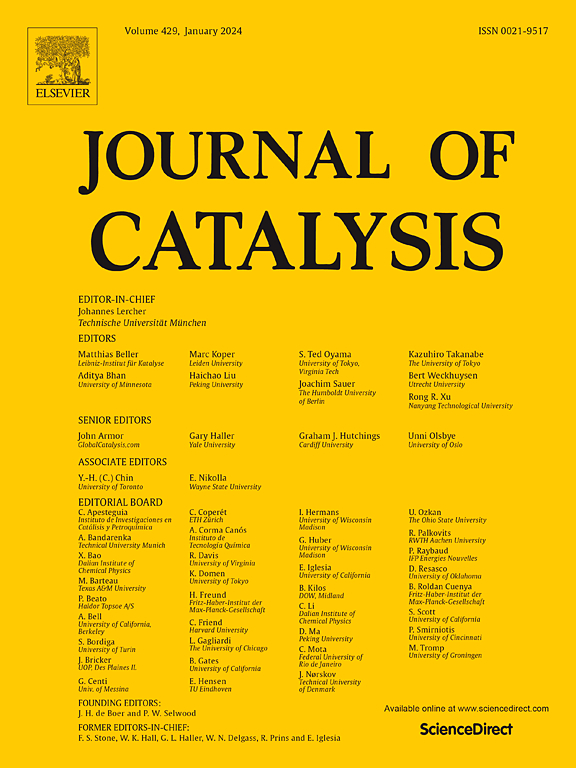通过可解释的机器学习了解金属氧化物在钌基氨合成催化剂中的作用
IF 6.5
1区 化学
Q2 CHEMISTRY, PHYSICAL
引用次数: 0
摘要
由于酸性、碱性和表面缺陷,金属氧化物载体在非均相催化中的作用是复杂的。经过实验数据训练的可解释机器学习模型可能会对这些复杂性产生新的见解,而这些见解很少通过详细的催化剂表征来验证。本研究利用Shapley添加剂解释(SHAP)探讨了金属氧化物载体在钌基氨合成催化剂中的作用。确定了载体金属氮化物生成能和载体金属氢化物生成能是表征氨合成活性的关键描述符。这些描述符以及相关催化剂的氨温程序解吸和氢温程序解吸表征提示了控制氨合成反应的新过程。建议金属氧化物载体除碱性外,还应具有一定的酸度以减轻氨抑制作用,形成金属氢化物以减轻氢抑制作用。本文章由计算机程序翻译,如有差异,请以英文原文为准。


Understanding the role of metal oxide support in ruthenium-based catalysts for ammonia synthesis via interpretable machine learning
The role of metal oxide supports is complex in heterogeneous catalysis due to acidity, basicity, and surface defects. Interpretable machine learning models trained on experimental data could lead to new insights about these complexities, which are rarely verified through detailed catalyst characterization. This study explores the role of metal oxide supports for the Ru-based ammonia synthesis catalysts using Shapley additive explanations (SHAP). The support metal nitride formation energy and the support metal hydride formation energy were identified as critical descriptors that could describe the ammonia synthesis activity. These descriptors and the related catalyst characterization by Ammonia-Temperature Programmed Desorption and Hydrogen-Temperature Programmed Desorption suggest new processes that could govern the ammonia synthesis reaction. It is suggested that in addition to basicity, the metal oxide support should possess a certain acidity to alleviate ammonia inhibition and form metal hydrides to alleviate hydrogen inhibition.
求助全文
通过发布文献求助,成功后即可免费获取论文全文。
去求助
来源期刊

Journal of Catalysis
工程技术-工程:化工
CiteScore
12.30
自引率
5.50%
发文量
447
审稿时长
31 days
期刊介绍:
The Journal of Catalysis publishes scholarly articles on both heterogeneous and homogeneous catalysis, covering a wide range of chemical transformations. These include various types of catalysis, such as those mediated by photons, plasmons, and electrons. The focus of the studies is to understand the relationship between catalytic function and the underlying chemical properties of surfaces and metal complexes.
The articles in the journal offer innovative concepts and explore the synthesis and kinetics of inorganic solids and homogeneous complexes. Furthermore, they discuss spectroscopic techniques for characterizing catalysts, investigate the interaction of probes and reacting species with catalysts, and employ theoretical methods.
The research presented in the journal should have direct relevance to the field of catalytic processes, addressing either fundamental aspects or applications of catalysis.
 求助内容:
求助内容: 应助结果提醒方式:
应助结果提醒方式:


